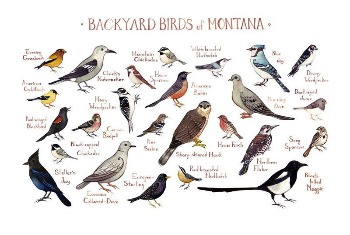The mountainous regions of Montana are home to over 400 bird species. Learning about all of them may be a dream come true for an avid birdwatcher, but beginners may find this intimidating.
That being said…
We prepared a guide on 17 common birds of Montana so you can start with a few species to identify.
Plus, these are all birds that you can potentially attract to your backyard. We also shared some tips below on how you can observe these birds up close. Read on!
The 17 Common Bird Species Of Montana
1. Black-Capped Chickadee (Poecile atricapillus)
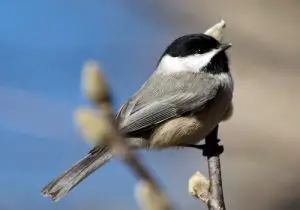
As the name suggests, the Black-Capped Chickadee has a black cap paired with its distinctive white cheeks and black bib. Meanwhile, its upperparts are pale gray while its underparts are slightly brown.
You can find Black-Capped Chickadees in Montana year-round, usually around deciduous and mixed forests. During winter, they're also found in suburban areas. You may often see them in flocks, especially with other birds like nuthatches, kinglets, and creepers.
These small birds mostly eat insects and varying amounts of vegetable matter (seeds and berries) depending on the season.
You can easily attract Black-Capped Chickadees with suet, sunflower seeds, and peanuts. However, don't expect them to stay because they usually fly elsewhere to eat. You can encourage them further by installing a nest box before breeding season.
These birds cache food in different hiding places and can remember thousands of locations. There must be a lot of brainpower beneath that black cap!
2. Blue Jay (Cyanocitta cristata)
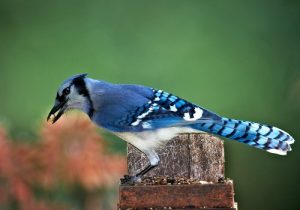
The Blue Jay is one of the most distinctive birds in Montana. It has pale gray underparts, while its upperparts have striking patterns of blue, black, and white.
Blue Jays are uncommon, year-round residents only in eastern Montana. You may only find them in the state's western regions during winter.
They're usually located in deciduous and mixed forests, although they avoid purely coniferous forests. Other typical locations are farmlands, towns, parks, and suburban gardens.
Blue Jays are omnivorous, although most of their diet comprises vegetable matter. You'll see them foraging in trees, shrubs, and on the ground.
Meanwhile, you can attract them with bird feeders containing peanuts, suet, or sunflower seeds. They will also often drink from your birdbath.
The Blue Jay is not actually blue despite its name and appearance. Instead, the structure of its feathers refracts light that makes it appear blue. When you crush its feathers, that structure is destroyed, and the blue color will disappear.
3. Brown-Headed Cowbird (Molothrus after)
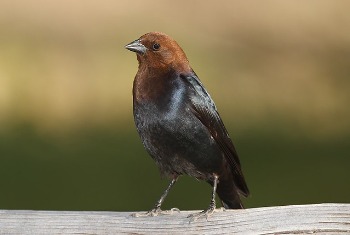
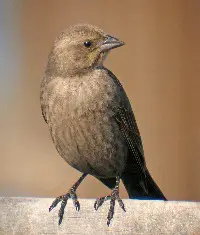
The Brown-Headed Cowbird has a strong sexual dimorphism. The male has a glossy brown head and an iridescent black body, whereas the female is dull brown overall.
Brown-Headed Cowbirds are present in Montana during summer. They're usually around open habitats, such as forest edges, fields, pastures, agricultural lands, and suburban areas.
These birds primarily feed on seeds and insects, although they tend to eat more seeds during winter. You'll usually see them foraging on the ground, flocking with other blackbird species.
Brown-Headed Cowbirds will readily visit your backyard if there's some open ground or if you scatter some grains for ground-feeding birds. If your backyard has enough space for livestock, there's a good chance you'll see them around.
Brown-Headed Cowbirds are brood parasites. A female would lay eggs in another bird's nest, tricking the parent into raising a young cowbird.
4. Chipping Sparrow (Spizella passerina)
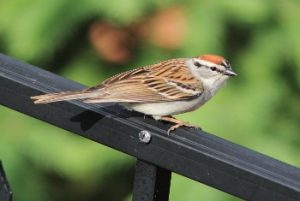
The Chipping Sparrow has a gray head, rump, and underparts, while its upperparts are a black-streaked brown. Additionally, it has a rufous crown with a black line through the eye.
Chipping Sparrows are common but only present in Montana during spring and summer. You can find them in open woodlands, forest edges, parks, suburbs, and other human-altered habitats.
They primarily feed on insects during summer, but their diet can include many seeds during fall and winter. You'll usually see them foraging on the ground.
Chipping Sparrows are relatively tame and will readily visit your backyard, especially if you have trees and bird feeders. They'll eat many kinds of seeds, especially black oil sunflower seeds.
This species was the original number one "city sparrow" until the House Sparrow was introduced in the USA.
5. Dark-Eyed Junco (Junco hyemalis)
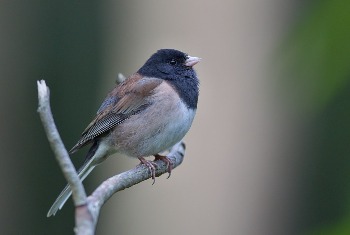
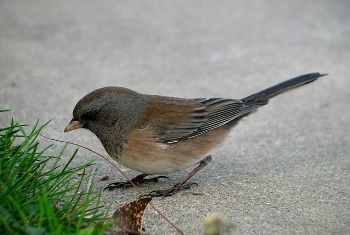
The Dark-Eyed Junco has many color variations, although they all have dark eyes, a pink bill, a white belly, and a dark tail with white outer feathers.
You'll usually see the "Oregon" variation in Montana, which has a black head, chestnut-brown back, dark gray wings, and brown-washed sides. Females are slightly duller than males.
Dark-Eyed Juncos are present in most areas of Montana yearly, although they're only winter birds in the northeast.
During their breeding season, they're usually in openings and edges of coniferous and mixed woods. Meanwhile, during winter, you may see them in other habitats like fields, roadsides, thickets, and suburban areas.
Dark-Eyed Juncos usually forage on the ground, feeding on seeds, insects, and some berries. They will visit backyards for various seeds scattered around or in platform feeders.
These birds will flash their white outer tail feathers to alarm other flock members.
6. Downy Woodpecker (Dryobates pubescens)
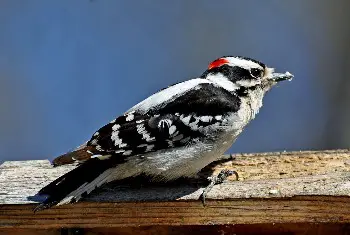
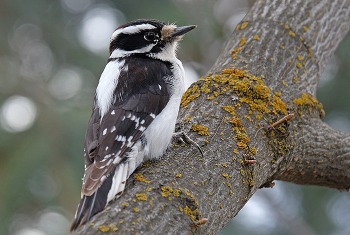
The Downy Woodpecker is a small bird that's pale below and black-and-white above. You can quickly identify the male with its red crown patch, although the female lacks this feature.
Downy Woodpeckers are year-round residents throughout Montana, where they mainly inhabit deciduous woodlands. However, you may also find them in brushy or weedy areas, parks, orchards, and suburban areas. They usually flock with chickadees and nuthatches.
They mainly eat insects, although seeds and berries are also parts of their diet. You'll see them foraging on trees, shrubs, and weed stalks.
Downy Woodpeckers are the most likely woodpecker species to appear in backyards. They prefer suet, but they'll also eat peanuts and black oil sunflower seeds. Sometimes, they may even eat from oriole and hummingbird feeders.
As the smallest woodpecker species in North America, the Downy Woodpecker can access food sources and habitats that other woodpeckers can't.
7. House Finch (Haemorhous mexicanus)
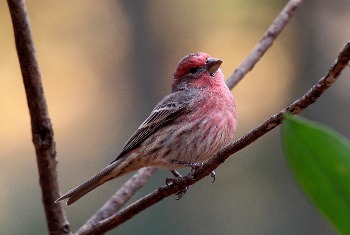
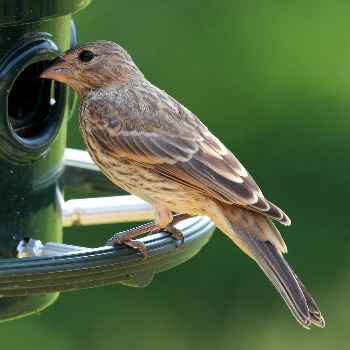
The House Finch is brown-streaked overall, but the colors are lighter beneath and darker above. Adult males are easier to recognize because they have a red wash on the head, breast, and rump.
House Finches are widespread; you can see them in Montana all year. They're located in various places associated with humans, such as cities, suburbs, farmlands, and towns. However, they may also be in their native habitats of grasslands, deserts, and open woods.
Almost all of their diet comprises vegetables such as seeds, buds, and berries. You'll usually see them foraging in flocks, except when they're nesting.
House Finches can be attracted by sunflower and nyjer seeds. However, brace yourself as once these backyard birds discover your feeder, they'll undoubtedly bring their friends along.
The House Finch was originally native to the Western USA. Once it was introduced to New York, the population flourished in the Eastern USA.
8. House Sparrow (Passer domesticus)
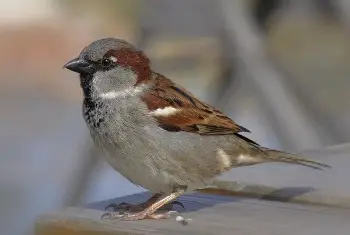
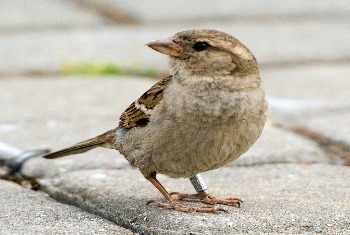
The House Sparrow is an invasive species with pale gray underparts and brown upperparts with black streaks. The male has a gray cap and black patch on its throat, whereas the female lacks these features and is duller overall.
House Sparrows are widespread throughout Montana year-round. As the name suggests, you can find them in most places, such as houses and other artificial structures. You would probably find some of them just by walking around the neighborhood.
House Sparrows are also one of the most common backyard birds, and they will eat most kinds of birdseed. However, we don't recommend attracting them because many consider them pests, which can harm native birds.
House Sparrows return to their birthplace after every migration. This phenomenon is called philopatry, which is helpful in reproduction and survival.
9. House Wren (Troglodytes aedon)
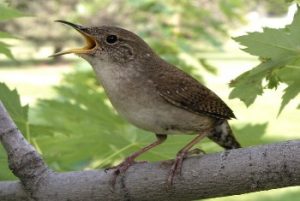
The House Wren is brown overall, albeit with different shades. Its body is lighter beneath and darker above, while its wings and tail have many dark bars.
House Wrens have a wide distribution in both North and South America. However, they're only present in Montana during the breeding season. They can be seen in open woodlands, forest edges, suburbs, city parks, and other areas with scattered grass and trees.
You may find them foraging actively on dense vegetation. These birds primarily feed on insects, so they won't visit your feeders.
However, House Wrens are still common backyard birds in Montana because they often nest in birdhouses and human homes. Having brush piles or native plants around encourages them as well.
These brown birds are incredibly territorial, wherein they would often destroy other birds' eggs by piercing and removing them from the nest.
10. Mountain Chickadee (Poecile gambeli)
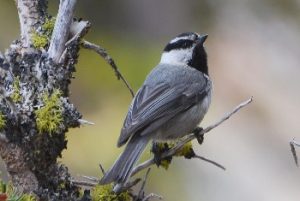
The Mountain Chickadee is easily confused with the Black-Capped Chickadee. They have very similar plumages, even down to the black cap. However, note that this species has white eyebrows, which sets it apart from other chickadees.
Mountain Chickadees are present in Montana year-round, but only in the state's western regions. As the name suggests, they're usually around dry, coniferous mountain forests. However, they can also occur in lowlands during winter.
These birds mainly consume insects, seeds, and berries. It may be challenging to find one as they tend to feed high up in trees. During winter, they usually flock with nuthatches and kinglets.
Despite their usual habitat, Mountain Chickadees will readily visit nest boxes and most feeder types that contain various seeds, suet, or peanut butter.
A half-ounce Mountain Chickadee only needs about 10 calories per day to survive, equivalent to about one-twentieth of an ounce of peanut butter. They'll stash any excess food they find for later.
11. Mourning Dove (Zenaida macroura)
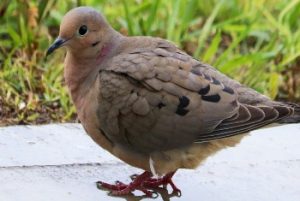
The Mourning Dove is a small-headed bird about the size of a robin. It has pale brown underparts and gray-brown upperparts. Some of its other characteristics are the big black eyes and the black spots on its brown wings.
Mourning Doves are found in most parts of Montana during breeding seasons. However, some are found year-round in the southwest. You can find them almost anywhere with many trees and shrubs, except for deep woods.
They almost exclusively eat seeds. On rare occasions, they may feed on snails and insects. You'll usually see them foraging on the ground, though they may sometimes perch on plants.
In backyards, Mourning Doves will mostly eat seeds, especially millet, scattered on the ground or in low feeders.
Male and female Mourning Doves can secrete "pigeon milk," a substance high in fat and protein that they feed their young.
12. Pine Siskin (Spinus pinus)

Like many birds, the Pine Siskin has a brown-streaked body that's lighter below and darker above. However, you can recognize this species through the yellow patches on its wings and rump, and its heavily-notched tail.
Pine Siskins are found in western Montana year-round, whereas they're only in eastern Montana during winter. They're usually in coniferous and mixed forests but also in parks, thickets, and fields.
They primarily feed on vegetable matter and some insects, often foraging in flocks even in nesting seasons.
Pine Siskins are also familiar backyard birds in Montana, especially during winter when conifer seeds become scarce. They particularly favor hulled sunflower and nyjer seeds.
Pine Siskins can increase their metabolic rate up to five times to get through cold winter nights.
13. Red-Breasted Nuthatch (Sitta canadensis)
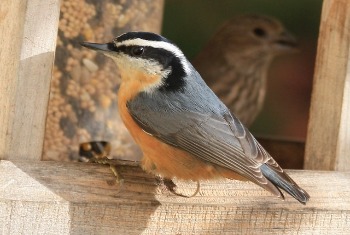
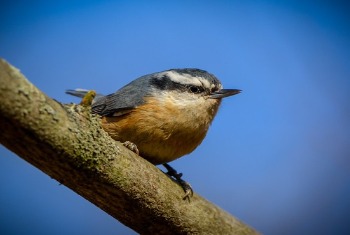
Apart from its breast, the Red-Breasted Nuthatch has a red belly and sides. Meanwhile, its upperparts are blue-gray, and its head has black-and-white stripes. Females are slightly duller than males.
Red-Breasted Nuthatches are present in southwestern Montana year-round. Meanwhile, you may only find them during winter in the northeast. They prefer living in mountains and coniferous forests, especially mature ones, as they use decaying wood as nesting sites.
These birds feed mainly on insects during summer and seeds during winter. They forage by climbing tree trunks and branches, although they may also catch flying insects mid-air.
Red-Breasted Nuthatches show little fear of humans and often come to backyard feeders containing sunflower seeds, peanuts, or suet. You may also put up a nesting box before the breeding season to attract a breeding pair.
Red-Breasted Nuthatches collect resin from conifer trees and put it around their nest entrance to keep predators and competitors away.
14. Red-Winged Blackbird (Agelaius phoeniceus)
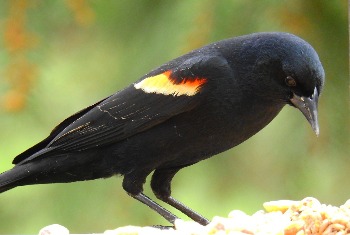
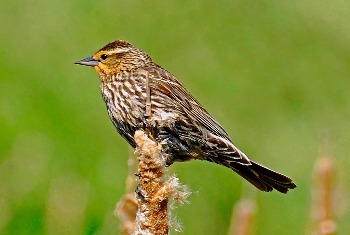
Despite its name, the Red-Winged Blackbird has black wings. The "red-winged" part comes from its shoulders, which you can easily recognize because the rest of its body is black.
However, this color scheme is for males only. The females are brown overall, but they have other identifiable features, such as dull red shoulder markings and a pale yellow tint on the face.
Red-Winged Blackbirds usually occur in Montana during breeding, although some may stay year-round in the southwest. They prefer open areas near water, such as marshes, brushy swamps, weedy fields, and mudflats.
They eat mostly seeds and insects, usually foraging on the ground with other blackbirds and starlings. Red-Winged Blackbirds will also take mixed grains and seeds scattered on the ground or in bird feeders.
The Red-Winged Blackbird roosts in flocks no matter the season. During winter, some flocks may even consist of several million birds.
15. Song Sparrow (Melospiza melodia)
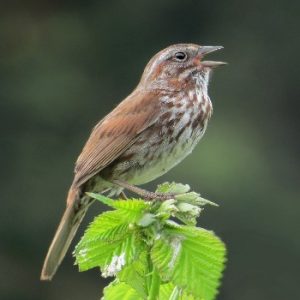
The Song Sparrow is a medium-sized sparrow with gray and brown upperparts and white underparts with brown streaks. That's pretty much it.
Song Sparrows are present in southwest Montana all year but only during summer in the northeast. These medium-sized birds are often in various open habitats, such as marsh edges, thickets, city parks, and well-vegetated gardens.
They mainly forage on the ground, eating many insects during summer and seeds during winter. Song Sparrows also frequently visit bird feeders, especially for black oil sunflower seeds. They may even nest somewhere near your house.
As the name suggests, the Song Sparrow is one of the most persistent singers, especially during breeding seasons.
16. Yellow-Rumped Warbler (Setophaga coronata)
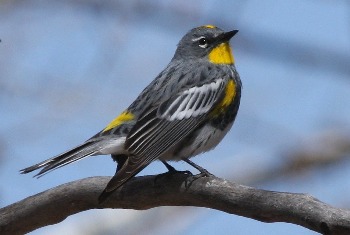
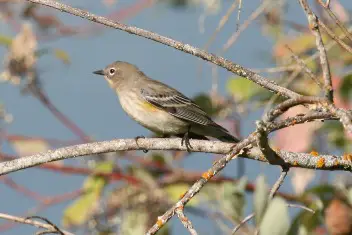
The Yellow-Rumped Warbler has two distinct subspecies: "Myrtle" and "Audubon's." The latter occurs in the Western USA.
During breeding seasons, the "Audubon's" has a dark-streaked body that's blue-gray above and white below. It also has a distinctive bright yellow throat, crown, sides, and rump. Meanwhile, its upperparts become brown instead during non-breeding seasons.
Yellow-Rumped Warblers are found in western Montana during summer and eastern Montana during spring and fall. They usually reside in open coniferous forests but may visit shrubby habitats like parks and residential areas during the fall season.
These birds primarily eat berries and insects, foraging on the ground and around trees and shrubs. You can attract them with sunflower seed, suet, and raisins.
Yellow-Rumped warblers can digest the waxes found in wax myrtles and bayberries. This allows them to winter farther north than other warblers.
17. Yellow Warbler (Setophaga petechia)

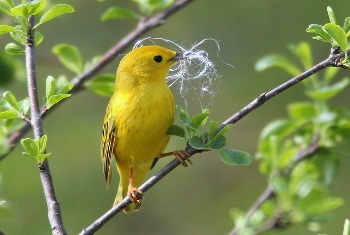
The Yellow Warbler is a small bird about the same size as a sparrow. It has a yellow body overall, accompanied by its dark wings. The male also has rust-brown streaks on the breast and sides, whereas the female doesn't.
Yellow Warblers visit North America during spring and summer, then migrate to Central and South America during winter. They inhabit various habitats, including streamside willows, woodland edges, farmlands, shrubby thickets, orchards, and towns.
Their diet consists of mostly insects, especially various caterpillars. They may also eat some fruits and berries. Look for them foraging on top of shrubs and trees.
Unfortunately, they probably won't visit bird feeders due to their diet. Instead, you can attract Yellow Warblers with native plants that can promote insect life in your backyard.
Yellow Warbler nests are frequently parasitized by Brown-Headed Cowbirds. The warbler will often build directly atop the parasitized nest, sometimes resulting in a six-layered nest.
Bird Point: North Carolina is another state to visit for your bird-watching hobby. Learn more about the different species inhabiting this state -- North Carolina Birds: 18 Species To Capture Into Your Senses.
Watch This!
Frequently Asked Questions
What is the smallest bird in Montana?
The smallest bird in Montana is the Calliope Hummingbird. This tiny bird only visits during summer, so prepare your hummingbird feeders then.
Do finches live in Montana?
Yes. Although we only included the House Finch and Pine Siskin in this list, there are other finches in Montana, such as the American Goldfinch and Cassin's Finch.
How do I identify birds in my backyard?
Feathers are the most reliable identifier because there are many flashy and colorful birds in Montana. For other birds that simply look brown, you can rely on biological features instead, such as body size and structure.
Conclusion
Attracting birds to your backyard is a great way to observe them in all their glory. However, there's still so much to see in the wilderness of Montana.
If you want to take your experience to the next level, check out the Montana Audubon Society. This is a great way to get involved in different events and learn more about the local birds.
That said, we hope our guide helped you on your bird-watching adventures. Who knows? Maybe you'll be able to identify all the birds of Montana someday.

